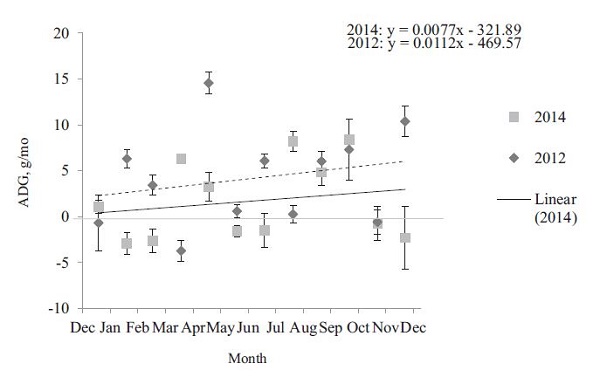Abstract
Growth patterns of captive leopard tortoises (Stigmochelys pardalis) have been compared with those of free-ranging individuals.2,4-5 Although useful comparative references for captive animal management, the lack of quantified food intake, and opportunistic morphometric sampling associated with wild specimens limits their application. Average daily gain (ADG) of 17 female leopard tortoises born of the same clutch, was analyzed over two 12-mo periods: Period A was January through December 2012 (ages 2,650–3,015 days) and Period B was January through December 2014 (ages 3,380–3,745 days). Food offered supplied 50% of herbivorous reptile field metabolic rate (FMR, kJ ME/day) based on weekly body weight throughout both periods.3 Daily food intake was quantified as the difference between food offered and orts remaining after 10 hr. On a dry matter basis, calculated metabolizable energy (ME) (12.93, 13.78 kJ/g), crude protein (CP) (13.7%, 16.3%), crude fat (CFat) (3.8%, 6.8%), and structural carbohydrates (crude fiber [CF]) (22.3%, 17.7%), differed for commercial diet blends consumed during Periods A and B, respectively. The contributions (%) of CP and CF to consumed ME were consistent with previous recommendations.1 NDF content was 51.4% and 40.7%, respectively. Absolute amount of ADG was significantly greater during Period A (p<0.05) (Figure 1). Periods reported here represent ages beyond those for which growth has been previously described.4 Lower Period B growth rates may 1) be a result of reduced energy utilization associated with the nutrient profile consumed over that time and/or 2) coincide with a species typical, age-related decline associated with maturity.
Figure 1. Mean average daily gain (ADG) (±SD) of female leopard tortoises (Stigmochelys pardalis) (n=17) fed isoenergetic diets over two 12-mo periods (Jan–Dec 2012 and Jan–Dec 2014)

Literature Cited
1. Donoghue S, McKeown S. Nutrition of captive reptiles. Vet Clin North Am Exot Anim Pract. 1999;2:69–91.
2. Hailey A, Coulson IM. The growth pattern of the African tortoise Geochelone pardalis and other chelonians. Can J Zool [Internet]. 1999 [cited 2015 March 5];77:181–193. Available from: doi:10.1139/z98-225.
3. Nagy KA, Girard IA, Brown TK. Energetics of free-ranging mammals, reptiles, and birds. Annu Rev Nutr. 1999;19:247–277.
4. Rall M. Observations on the growth of the leopard tortoise Geochelone pardalis in captivity. Afr J Herpetol. [Internet]. 1988 [cited 2015 March 5];35:7–8. Available from: doi:10.1080/04416651.1988.9650198.
5. Ritz J, Hammer C, Clauss M. Body size development of captive and free-ranging leopard tortoises (Geochelone pardalis). Zoo Biol [Internet]. 2010 [cited 2015 March 5];29:517–525. Available from: doi:10.1002/zoo.20273.